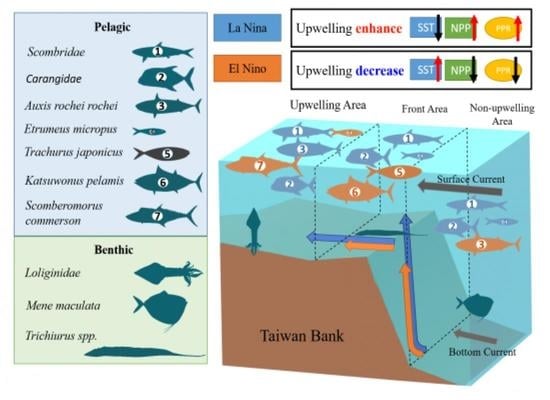Assessing Summertime Primary Production Required in Changed Marine Environments in Upwelling Ecosystems Around the Taiwan Bank
Abstract
1. Introduction
2. Materials and Methods
2.1. Fishery Data Collection
2.2. Environmental Data and Climate Index
2.3. Upwelling Size
2.4. PPR and Contribution to PPR
2.5. Statistical Models of Fishery Resources in Each Habitat
3. Results
3.1. Environment and Structure of Fishery Resources in TB Region
3.2. Variations in Distribution of Fishery Resources and PPR
3.3. Effects of Environmental and Climatic Factors on PPR
4. Discussion
4.1. Environmental Characteristics of Three TB Habitats
4.2. Fishery Resource Structure and PPR in Three TB Habitats
4.3. Explanatory Variables in GAM Analysis
4.4. Effects of Climate Change on the TB
5. Conclusions
Author Contributions
Funding
Acknowledgments
Conflicts of Interest
References
- Tang, D.L.; Kester, D.R.; Ni, I.H.; Kawamura, H.; Hong, H.S. Upwelling in the Taiwan Strait during the summer monsoon detected by satellite and shipboard measurements. Remote Sens. Environ. 2002, 83, 457–471. [Google Scholar] [CrossRef]
- Tang, D.L.; Kawamura, H.; Guan, L. Long-time observation of annual variation of Taiwan Strait upwelling in summer season. Adv. Space Res. 2004, 33, 307–312. [Google Scholar] [CrossRef]
- Jiang, Y.; Chai, F.; Wan, Z.; Zhang, X.; Hong, H. Characteristics and mechanisms of the upwelling in the southern Taiwan Strait: A three-dimensional numerical model study. J. Oceanogr. 2011, 67, 699–708. [Google Scholar] [CrossRef]
- Hu, J.; Kawamura, H.; Hong, H.; Pan, W. A review of research on the upwelling in the Taiwan Strait. Bull. Mar. Sci. 2003, 73, 605–628. [Google Scholar]
- Zhang, F.; Li, X.; Hu, J.; Sun, Z.; Zhu, J.; Chen, Z. Summertime sea surface temperature and salinity fronts in the southern Taiwan Strait. Int. J. Remote Sens. 2014, 35, 4452–4466. [Google Scholar] [CrossRef]
- Lan, K.W.; Kawamura, H.; Lee, M.A.; Chang, Y.; Chan, J.W.; Liao, C.H. Summertime sea surface temperature fronts associated with upwelling around the Taiwan Bank. Cont. Shelf Res. 2009, 29, 903–910. [Google Scholar] [CrossRef]
- Chang, Y.-L.; Miyazawa, Y.; Guo, X. Effect of mesoscale eddies on the Taiwan strait current. J. Phys. Oceanogr. 2015, 45, 1651–1666. [Google Scholar] [CrossRef]
- Zu, T.; Wang, D.; Yan, C.; Belkin, I.; Zhuang, W.; Chen, J. Evolution of an anticyclonic eddy southwest of Taiwan. Ocean Dyn. 2013, 63, 519–531. [Google Scholar] [CrossRef]
- Logerwell, E.A.; Smith, P.E. Mesoscale eddies and survival of late stage Pacific sardine (Sardinops sagax) larvae. Fish. Oceanogr. 2001, 10, 13–25. [Google Scholar] [CrossRef]
- Kai, E.T.; Marsac, F. Influence of mesoscale eddies on spatial structuring of top predators’ communities in the Mozambique Channel. Prog. Oceanogr. 2010, 86, 214–223. [Google Scholar]
- Zhou, C.; He, P.; Xu, L.; Bach, P.; Wang, X.; Wan, R.; Tang, H.; Zhang, Y. The effects of mesoscale oceanographic structures and ambient conditions on the catch of albacore tuna in the South Pacific longline fishery. Fish. Oceanogr. 2020, 29, 238–251. [Google Scholar] [CrossRef]
- Hong, H.; Chai, F.; Zhang, C.; Huang, B.; Jiang, Y.; Hu, J. An overview of physical and biogeochemical processes and ecosystem dynamics in the Taiwan Strait. Cont. Shelf Res. 2011, 31, S3–S12. [Google Scholar] [CrossRef]
- Wang, Y.; Kang, J.H.; Ye, Y.Y.; Lin, G.M.; Yang, Q.L.; Lin, M. Phytoplankton community and environmental correlates in a coastal upwelling zone along western Taiwan Strait. J. Mar. Syst. 2016, 154, 252–263. [Google Scholar] [CrossRef]
- McClain, C.R. A decade of satellite ocean color observations. Annu. Rev. Mar. 2009, 1, 19–42. [Google Scholar] [CrossRef]
- Stuart, V.; Platt, T.; Sathyendranath, S. Remote sensing and fisheries: An introduction. ICES J. Mar. Sci. 2011, 68, 639–641. [Google Scholar] [CrossRef]
- Klemas, V. Fisheries applications of remote sensing: An overview. Fish. Res. 2013, 148, 124–136. [Google Scholar] [CrossRef]
- Sabatini, M.; Martos, P. Mesozooplankton features in a frontal area off northern Patagonia (Argentina) during spring 1995 and 1998. Sci. Mar. 2002, 66, 215–232. [Google Scholar] [CrossRef]
- Malakoff, D. New tools reveal treasures at ocean hot spots: Biologically rich ocean “fronts” attract marine life—And could be candidates for conservation, too. Science 2004, 304, 1104–1106. [Google Scholar] [CrossRef]
- Chou, M.Y. Application Fishing Activity Data to Explore the Fishing Grounds Distribution Characteristics of Coastal Fisheries in Taiwan. Master’s Thesis, National Taiwan Ocean University, Keelung, Taiwan, 2017. [Google Scholar]
- Lan, K.W.; Zhang, C.I.; Kang, H.J.; Wu, L.J.; Lian, L.J. Impact of fishing exploitation and climate change on the grey mullet mugil cephalus stock in the Taiwan Strait. Mar. Coast. Fish. 2017, 9, 271–280. [Google Scholar] [CrossRef]
- Ju, P.; Tian, Y.; Chen, M.; Yang, S.; Liu, Y.; Xing, Q.; Sun, P. Evaluating stock status of 16 commercial fish species in the coastal and offshore waters of taiwan using the CMSY and BSM methods. Front. Mar. Sci. 2020, 7, 618. [Google Scholar] [CrossRef]
- Wang, Y.; Wang, B.; Oh, J.-H. Impact of the preceding El Niño on the East Asian summer atmosphere circulation. J. Meteorol. Soc. Jpn. Ser. II 2001, 79, 575–588. [Google Scholar] [CrossRef]
- Wen, C. Impacts of El Niño and La Niña on the cycle of the East Asian winter and summer monsoon. Chin. J. Atmos. Sci. 2002, 5, 359–376. [Google Scholar]
- Chen, W.; Feng, J.; Wu, R. Roles of ENSO and PDO in the link of the East Asian winter monsoon to the following summer monsoon. J. Clim. 2013, 26, 622–635. [Google Scholar] [CrossRef]
- Kuo, N.J.; Ho, C.R. ENSO effect on the sea surface wind and sea surface temperature in the Taiwan Strait. Geophys. Res. Lett. 2004, 31. [Google Scholar] [CrossRef]
- Bell, J.D.; Ganachaud, A.; Gehrke, P.C.; Griffiths, S.P.; Hobday, A.J.; Hoegh-Guldberg, O.; Johnson, J.E.; Le Borgne, R.; Lehodey, P.; Lough, J.M.; et al. Mixed responses of tropical Pacific fisheries and aquaculture to climate change. Nat. Clim. Chang. 2013, 3, 591–599. [Google Scholar] [CrossRef]
- Hazen, E.L.; Jorgensen, S.; Rykaczewski, R.R.; Bograd, S.J.; Foley, D.G.; Jonsen, I.D.; Shaffer, S.A.; Dunne, J.P.; Costa, D.P.; Crowder, L.B. Predicted habitat shifts of Pacific top predators in a changing climate. Nat. Clim. Chang. 2013, 3, 234–238. [Google Scholar] [CrossRef]
- Liao, C.H.; Lan, K.W.; Ho, H.Y.; Wang, K.Y.; Wu, Y.L. Variation in the catch rate and distribution of swordtip squid uroteuthis edulis associated with factors of the oceanic environment in the southern east China Sea. Mar. Coast. Fish. 2018, 10, 452–464. [Google Scholar] [CrossRef]
- Lynam, C.P.; Llope, M.; Möllmann, C.; Helaouët, P.; Bayliss-Brown, G.A.; Stenseth, N.C. Interaction between top-down and bottom-up control in marine food webs. Proc. Natl. Acad. Sci. USA 2017, 114, 1952–1957. [Google Scholar] [CrossRef] [PubMed]
- Valiela, I. Marine Ecological Processes; Springer: New York, NY, USA, 1995; p. 546. [Google Scholar]
- Howarth, R.W. Nutrient limitation of net primary production in marine ecosystems. Annu. Rev. Ecol. Evol. Syst. 1988, 19, 89–110. [Google Scholar] [CrossRef]
- Chassot, E.; Mélin, F.; Le Pape, O.; Gascuel, D. Bottom-up control regulates fisheries production at the scale of eco-regions in European seas. Mar. Ecol. Prog. Ser. 2007, 343, 45–55. [Google Scholar] [CrossRef]
- Pauly, D.; Christensen, V. Primary production required to sustain global fisheries. Nature 1995, 374, 255–257. [Google Scholar] [CrossRef]
- Chassot, E.; Bonhommeau, S.; Dulvy, N.K.; Mélin, F.; Watson, R.; Gascuel, D.; Le Pape, O. Global marine primary production constrains fisheries catches. Ecol. Lett. 2010, 13, 495–505. [Google Scholar] [CrossRef]
- Lam, V.W.; Pauly, D. Status of fisheries in 13 Asian Large Marine Ecosystems. Deep Sea Res. Part II Top. Stud. Oceanogr. 2019, 163, 57–64. [Google Scholar] [CrossRef]
- Watson, R.; Zeller, D.; Pauly, D. Primary productivity demands of global fishing fleets. Fish Fish. 2014, 15, 231–241. [Google Scholar] [CrossRef]
- Knight, B.R.; Jiang, W. Assessing primary production constraints in New Zealand fisheries. Fish. Res. 2009, 100, 15–25. [Google Scholar] [CrossRef]
- Mantua, N.J.; Hare, S.R. The Pacific decadal oscillation. J. Oceanogr. 2002, 58, 35–44. [Google Scholar] [CrossRef]
- Linkin, M.E.; Nigam, S. The North Pacific Oscillation–west Pacific teleconnection pattern: Mature-phase structure and winter impacts. J. Clim. 2008, 21, 1979–1997. [Google Scholar] [CrossRef]
- Santos, F.; Gomez-Gesteira, M.; Decastro, M.; Alvarez, I. Differences in coastal and oceanic SST trends due to the strengthening of coastal upwelling along the Benguela current system. Cont. Shelf Res. 2012, 34, 79–86. [Google Scholar] [CrossRef]
- Pauly, D.; Christensen, V.; Dalsgaard, J.; Froese, R.; Torres, F. Fishing down marine food webs. Science 1998, 279, 860–863. [Google Scholar] [CrossRef]
- Strathmann, R.R. Estimating the organic carbon content of phytoplankton from cell volume or plasma volume 1. Limnol. Oceanogr. 1967, 12, 411–418. [Google Scholar] [CrossRef]
- Wood, S.M. Generalized Additive Models, an Introduction with R; Chapman and Hall: London, UK, 2006; p. 392. [Google Scholar]
- Maunder, M.N.; Punt, A.E. Standardizing catch and effort data: A review of recent approaches. Fish. Res. 2004, 70, 141–159. [Google Scholar] [CrossRef]
- Hu, J.; Wang, X.H. Progress on upwelling studies in the China seas. Rev. Geophys. 2016, 54, 653–673. [Google Scholar] [CrossRef]
- Yan, T.Z.; Li, H.Y.; Yu, G.Y. Numerical study on upwelling along the coast of Fujian coastal, I. Three dimensional numerical simulation of upwelling in Taiwan Strait. Hai Yang Xue Bao 1997, 19, 12–19. [Google Scholar]
- Zhang, W.-Z.; Chai, F.; Hong, H.-S.; Xue, H. Volume transport through the Taiwan Strait and the effect of synoptic events. Cont. Shelf Res. 2014, 88, 117–125. [Google Scholar] [CrossRef]
- Lin, P.G.; Chen, Z.Z.; Hu, J.Y.; Zhu, J.; Sun, Z.Y. Variation characteristics of upwelling in Taiwan Strait and its relationship with wind in summer 2011. J. Oceanogr. Taiwan Strait 2012, 31, 307–316. [Google Scholar]
- Yan, Y.M.; Dai, C.S.; Lu, J.B. An inquisition of fisheries resources management in Taiwan Strait and its adjacent waters. J. Oceanogr. Taiwan Strait 2000, 19, 249–253. [Google Scholar]
- Huang, T.-H.; Lun, Z.; Wu, C.-R.; Chen, C.-T.A. Interannual carbon and nutrient fluxes in Southeastern Taiwan Strait. Sustainability 2018, 10, 372. [Google Scholar] [CrossRef]
- Chang, Y. High Resolution Satellite-Derived Sea Surface Temperature Front and Its Application on Fishery in the Taiwan Strait. Ph.D. Thesis, National Taiwan Ocean University, Keelung, Taiwan, 2009. [Google Scholar]
- Lan, K.W.; Chang, Y.J.; Wu, Y.L. Influence of oceanographic and climatic variability on the catch rate of yellowfin tuna (Thunnus albacares) cohorts in the Indian Ocean. Deep Sea Res. Part II Top. Stud. Oceanogr. 2020, 175, 104681. [Google Scholar] [CrossRef]
- Lan, K.W.; Lian, L.J.; Li, C.H.; Hsiao, P.Y.; Cheng, S.Y. Validation of a primary production algorithm of vertically generalized production model derived from multi-satellite data around the waters of Taiwan. Remote Sens. 2020, 12, 1627. [Google Scholar] [CrossRef]
- Tripathy, S.C.; Ishizaka, J.; Siswanto, E.; Shibata, T.; Mino, Y. Modification of the vertically generalized production model for the turbid waters of Ariake Bay, southwestern Japan. Estuar. Coast. Shelf Sci. 2012, 97, 66–77. [Google Scholar] [CrossRef]
- Chen, Y.Q.; Shen, X.Q. Changes in the biomass of the East China Sea Ecosystem. In Large Marine Ecosystems of the Pacific Rim Assessment, Sustainability and Management; Sherman, K., Tang, Q., Eds.; Blackwell Science: Malden, MA, USA, 1999; pp. 221–239. [Google Scholar]
- Talaue-McManus, L. Transboundary Diagnostic Analysis for the South China Sea; UNEP: Bangkok, Thailand, 2000; Volume 14. [Google Scholar]
- Qu, J.G.; Xu, Z.L.; Long, Q.; Wang, L.; Shen, X.; Zhang, J.; Cai, Y. East China Sea, GIWA Regional Assessment 36; University of Kalmar: Kalmar, Sweden, 2005; pp. 10–11. [Google Scholar]
- Wilkinson, C.C.; DeVantier, L.L.; Talau-McMaanus, L.L.; Souter, D.D. South China Sea, GIWA Regional Assessment 54; University of Kalmar: Kalmar, Sweden, 2005; pp. 9–11. [Google Scholar]
- Tiedemann, M.; Brehmer, P. Larval fish assemblages across an upwelling front: Indication for active and passive retention. Estuar. Coast. Shelf Sci. 2017, 187, 118–133. [Google Scholar] [CrossRef]
- Chen, Y.T. Studies on the Fishing-Oceanic Conditions of Taiwanese Seine Fishery in the Sorthwastern Waters of Taiwan. Master’s Thesis, National Taiwan Ocean University, Keelung, Taiwan, 2017. [Google Scholar]
- Kiyota, M.; Yonezaki, S.; Watari, S. Characterizing marine ecosystems and fishery impacts using a comparative approach and regional food-web models. Deep Sea Res. Part II Top. Stud. Oceanogr. 2020, 175, 104773. [Google Scholar] [CrossRef]
- Chiou, W.D.; Chen, C.Y.; Wang, C.M.; Chen, C.T. Food and feeding habits of ribbonfish Trichiurus lepturus in coastal waters of south-western Taiwan. Fish. Sci. 2006, 72, 373–381. [Google Scholar] [CrossRef]
- Sassa, C.; Tsukamoto, Y.; Konishi, Y. Diet composition and feeding habits of Trachurus japonicus and Scomber spp. larvae in the shelf break region of the East China Sea. Bull. Mar. Sci. 2008, 82, 137–153. [Google Scholar]
- Wang, Y.C.; Lin, L.P.; Sheng, Y.L.; Weng, J.S.; Lee, M.A. Stomach content analysis of Etrumeus micropus in the coastal waters of Penghu off Taiwan in late summer. J. Fish. Soc. Taiwan 2017, 44, 135–145. [Google Scholar]
- Tanabe, T. Feeding habits of skipjack tuna Katsuwonus pelamis and other tuna Thunnus spp. juveniles in the tropical western Pacific. Fish. Sci. 2001, 67, 563–570. [Google Scholar] [CrossRef]
- Fuita, T.; Kitagawa, D.; Okuyama, Y.; Ishito, Y.; Inada, T.; Jin, Y. Diets of the demersal fishes on the shelf off Iwate, northern Japan. Mar. Biol. 1995, 123, 219–233. [Google Scholar] [CrossRef]
- Weng, J.S.; Lee, M.A.; Liu, K.M.; Hsu, M.S.; Hung, M.K.; Wu, L.J. Feeding ecology of juvenile yellowfin tuna from waters southwest of Taiwan inferred from stomach contents and stable isotope analysis. Mar. Coast. Fish. 2015, 7, 537–548. [Google Scholar] [CrossRef]
- Sassa, C.; Tsukamoto, Y.; Nishiuchi, K.; Konishi, Y. Spawning ground and larval transport processes of jack mackerel Trachurus japonicus in the shelf-break region of the southern East China Sea. Cont. Shelf Res. 2008, 28, 2574–2583. [Google Scholar] [CrossRef]
- Wang, K.Y.; Liao, C.H.; Lee, K.T. Population and maturation dynamics of the swordtip squid (Photololigo edulis) in the southern East China Sea. Fish. Res. 2008, 90, 178–186. [Google Scholar] [CrossRef]
- Ware, D.M. Aquatic ecosystems: Properties and models. In Fisheries Oceanography: An Intrgrative Approach to Fisheries Ecology and Management; Harrison, P.J., Parsons, T.R., Eds.; Balckwell Science: Oxford, UK, 2000; pp. 161–200. [Google Scholar]
- Ware, D.M.; Thomson, R.E. Bottom-up ecosystem trophic dynamics determine fish production in the northeast pacific. Science 2005, 308, 1280–1284. [Google Scholar] [CrossRef] [PubMed]
- Yatsu, A.; Aydin, K.Y.; King, J.R.; McFarlane, G.A.; Chiba, S.; Tadokoro, K.; Kaeriyama, M.; Watanabe, Y. Elucidating dynamic responses of North Pacific fish populations to climatic forcing: Influence of life-history strategy. Prog. Oceanogr. 2008, 77, 252–268. [Google Scholar] [CrossRef]
- Ottersen, G.; Kim, S.; Huse, G.; Polovina, J.J.; Stenseth, N.C. Major pathways by which climate may force marine fish populations. J. Mar. Syst. 2010, 79, 343–360. [Google Scholar] [CrossRef]
- Van Denderen, P.D.; Hintzen, N.T.; Rijnsdorp, A.D.; Ruardij, P.; van Kooten, T. Habitat-specific effects of fishing disturbance on benthic species richness in marine soft sediments. Ecosystems 2014, 17, 1216–1226. [Google Scholar] [CrossRef]
- Buhl-Mortensen, L.; Ellingsen, K.E.; Buhl-Mortensen, P.; Skaar, K.L.; Gonzalez-Mirelis, G. Trawling disturbance on megabenthos and sediment in the Barents Sea: Chronic effects on density, diversity, and composition. ICES J. Mar. Sci. 2016, 73, i98–i114. [Google Scholar] [CrossRef]
- Tzeng, W.N.; Tseng, Y.H.; Han, Y.S.; Hsu, C.C.; Chang, C.W.; Di Lorenzo, E.; Hsieh, C.H. Evaluation of multi-scale climate effects on annual recruitment levels of the Japanese eel, Anguilla japonica, to Taiwan. PLoS ONE 2012, 7, e30805. [Google Scholar] [CrossRef][Green Version]
- Wu, Y.L.; Lee, M.A.; Chen, L.C.; Chan, J.W.; Lan, K.W. Evaluating a suitable aquaculture site selection model for Cobia (Rachycentron canadum) during extreme events in the inner bay of the Penghu Islands, Taiwan. Remote Sens. 2020, 12, 2689. [Google Scholar] [CrossRef]
- Hong, H.S.; Shang, S.L.; Zhang, C.Y.; Huang, B.Q.; Hu, J.Y.; Huang, J.Q.; Lu, Z.B. Evidence of ecosystem response to the interannual environmental variability in the Taiwan Strait. Hai Yang Xue Bao 2005, 27, 63–69. [Google Scholar]
- Huang, Y.H. ENSO Effects on Marine Meteorology of Adjacent Waters Surrounding Taiwan. Master’s Thesis, National San Yet-sen University, Kaohsiung, Taiwan, 2005. [Google Scholar]
- Song, P.; Zhang, J.; Lin, L.; Xu, Z.; Zhu, X. Nekton species composition and biodiversity in Taiwan Strait. Sheng Wu Duo Yang Xing 2012, 20, 32–40. [Google Scholar]
- Ma, S.; Cheng, J.; Li, J.; Liu, Y.; Wan, R.; Tian, Y. Interannual to decadal variability in the catches of small pelagic fishes from China Seas and its responses to climatic regime shifts. Deep Sea Res. Part II Top. Stud. Oceanogr. 2019, 159, 112–129. [Google Scholar] [CrossRef]
- Yan, Y. Study on the relationship between the Sea Surface Temperature (SST) in NINO Region and the yield of pelagic fish in Minnan-Taiwan Bank Fishing Ground. J. Fujian Fish. 2006, 4, 11–15. [Google Scholar]
- Chang, Y.; Shimada, T.; Lee, M.A.; Lu, H.J.; Sakaida, F.; Kawamura, H. Wintertime sea surface temperature fronts in the Taiwan Strait. Geophys. Res. Lett. 2006, 33. [Google Scholar] [CrossRef]
- Tian, Y.; Kidokoro, H.; Watanabe, T.; Iguchi, N. The late 1980s regime shift in the ecosystem of Tsushima warm current in the Japan/East Sea: Evidence from historical data and possible mechanisms. Prog. Oceanogr. 2008, 77, 127–145. [Google Scholar] [CrossRef]
- Yasuda, I.; Sugisaki, H.; Watanabe, Y.; Minobe, S.S.; Oozeki, Y. Interdecadal variations in Japanese sardine and ocean/climate. Fish. Oceanogr. 1999, 8, 18–24. [Google Scholar] [CrossRef]
- Lan, K.W.; Lee, M.A.; Zhang, C.I.; Wang, P.Y.; Wu, L.J.; Lee, K.T. Effects of climate variability and climate change on the fishing conditions for grey mullet (Mugil cephalus L.) in the Taiwan Strait. Clim. Chang. 2014, 126, 189–202. [Google Scholar] [CrossRef]
- Barnston, A.G.; Livezey, R.E. Classification, seasonality and persistence of low-frequency atmospheric circulation patterns. Mon. Weather Rev. 1987, 115, 1083–1126. [Google Scholar] [CrossRef]
- Feldstein, S.B. The timescale, power spectra, and climate noise properties of teleconnection patterns. J. Clim. 2000, 13, 4430–4440. [Google Scholar] [CrossRef]
- Baxter, S.; Nigam, S. Key role of the North Pacific Oscillation–west Pacific pattern in generating the extreme 2013/14 North American winter. J. Clim. 2015, 28, 8109–8117. [Google Scholar] [CrossRef]
- Lee, M.A.; Kuo, Y.C.; Chan, J.W.; Chen, Y.K.; Teng, S.Y. Long-term (1982–2012) summertime sea surface temperature variability in the Taiwan Strait. Terr. Atmos. Ocean. Sci. 2015, 26, 183–192. [Google Scholar] [CrossRef][Green Version]
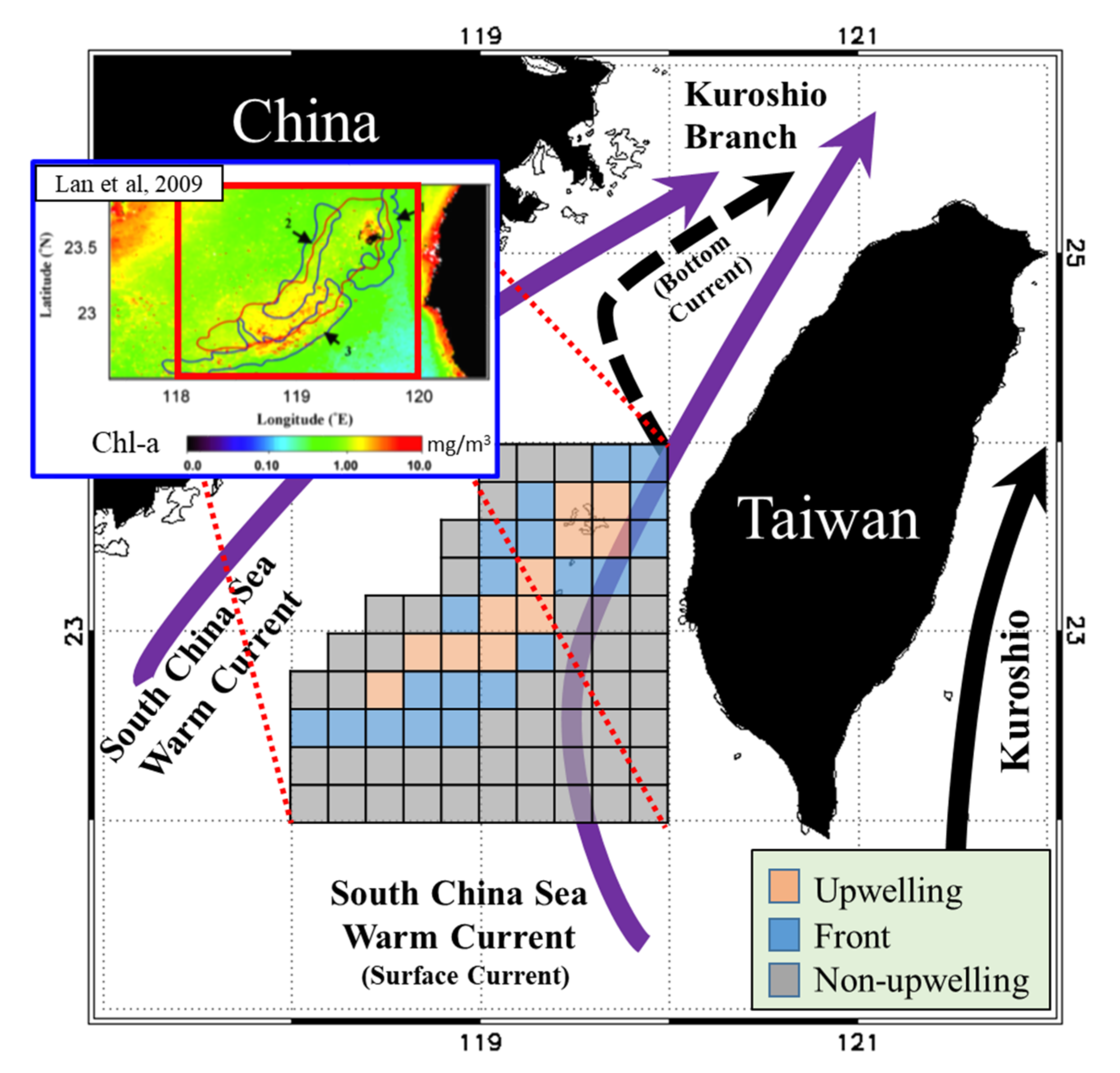
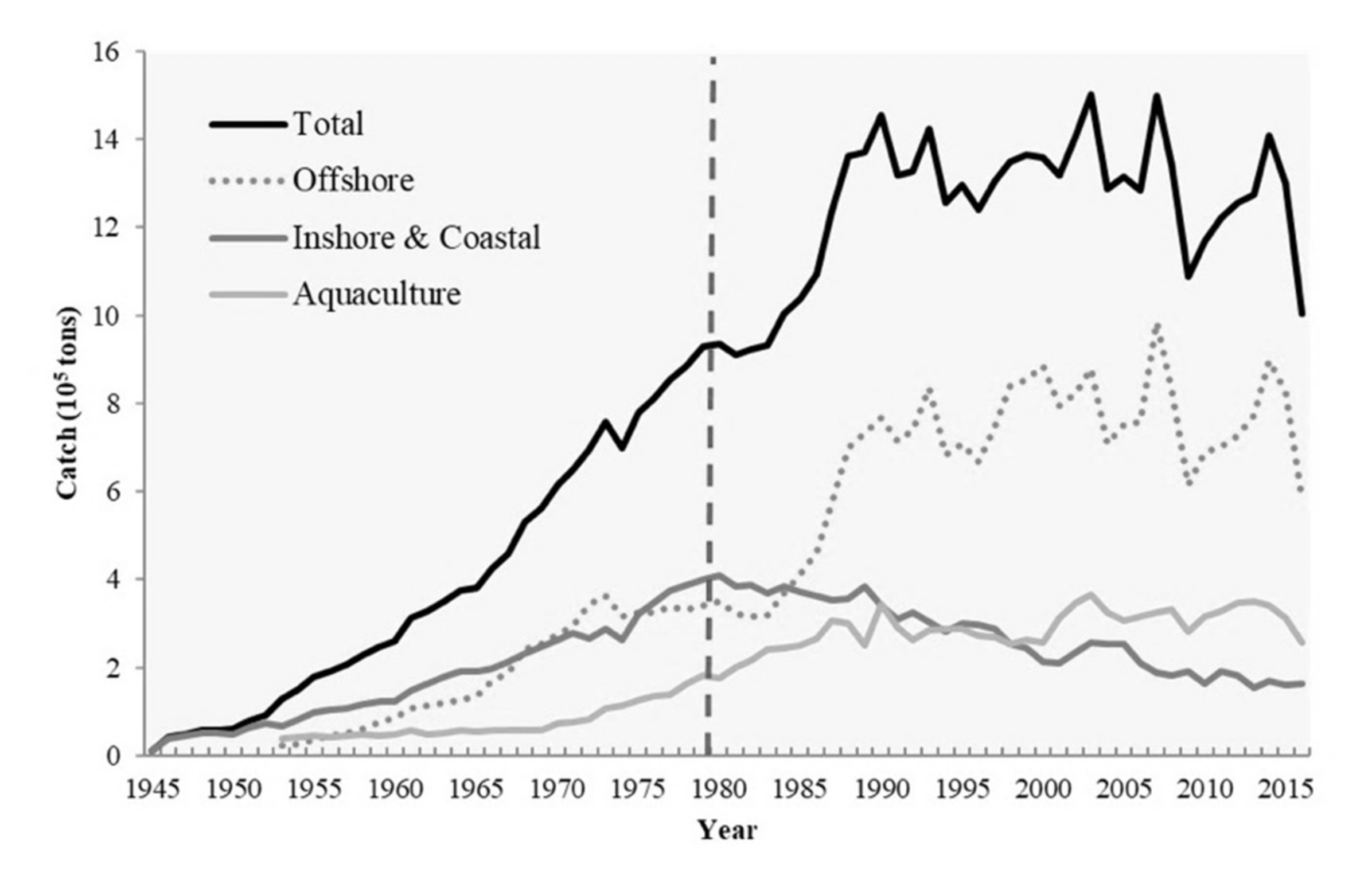
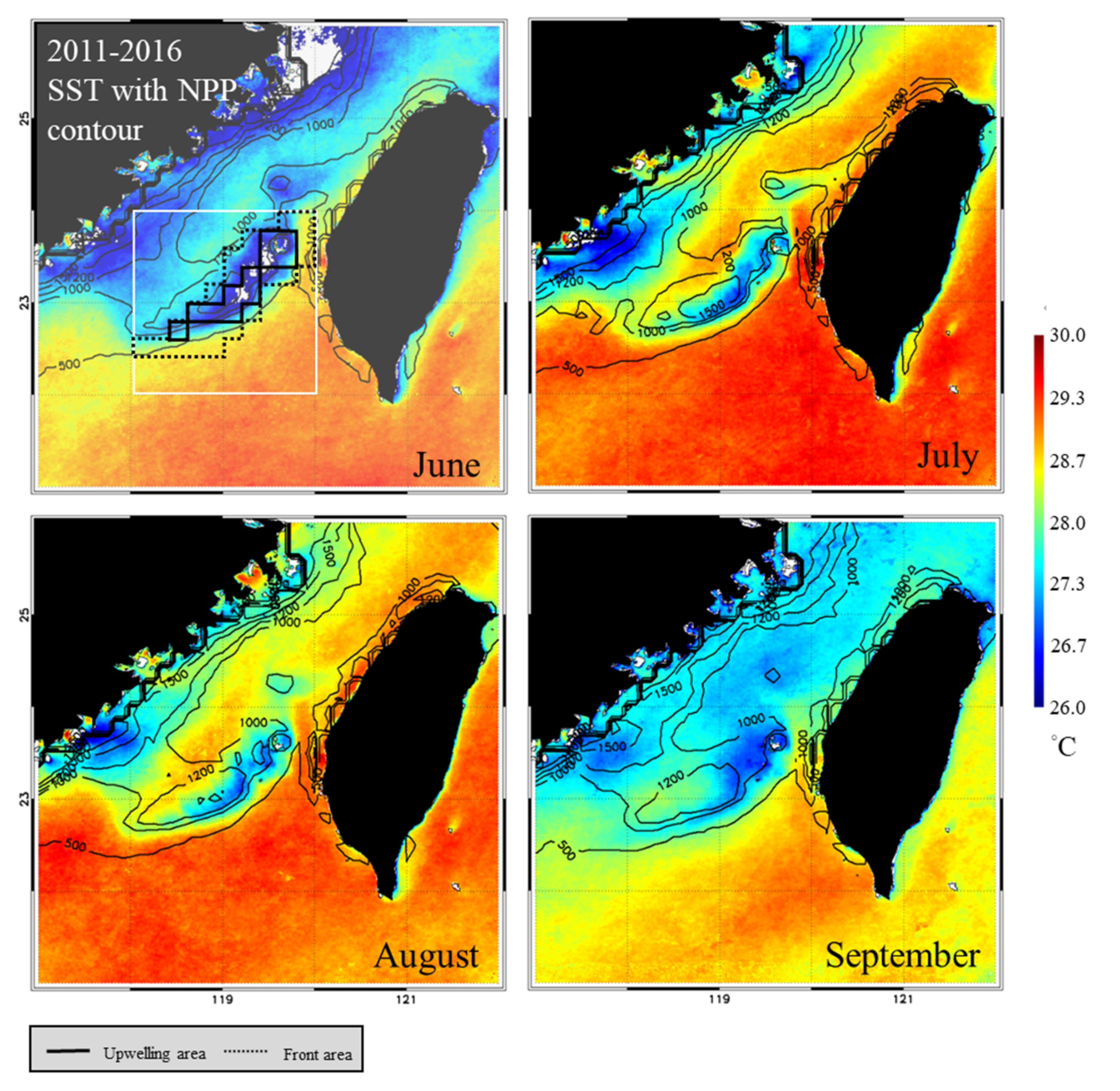

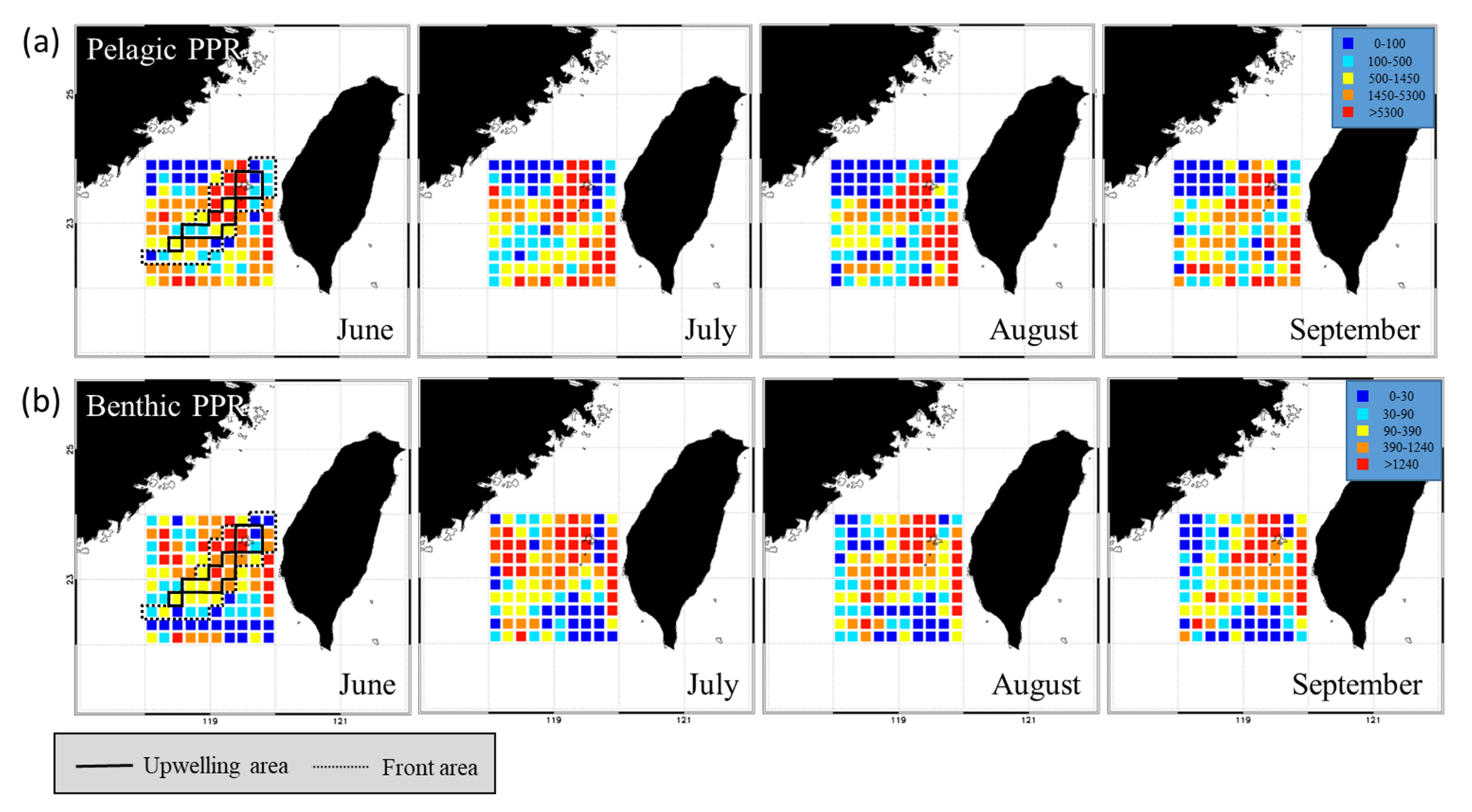
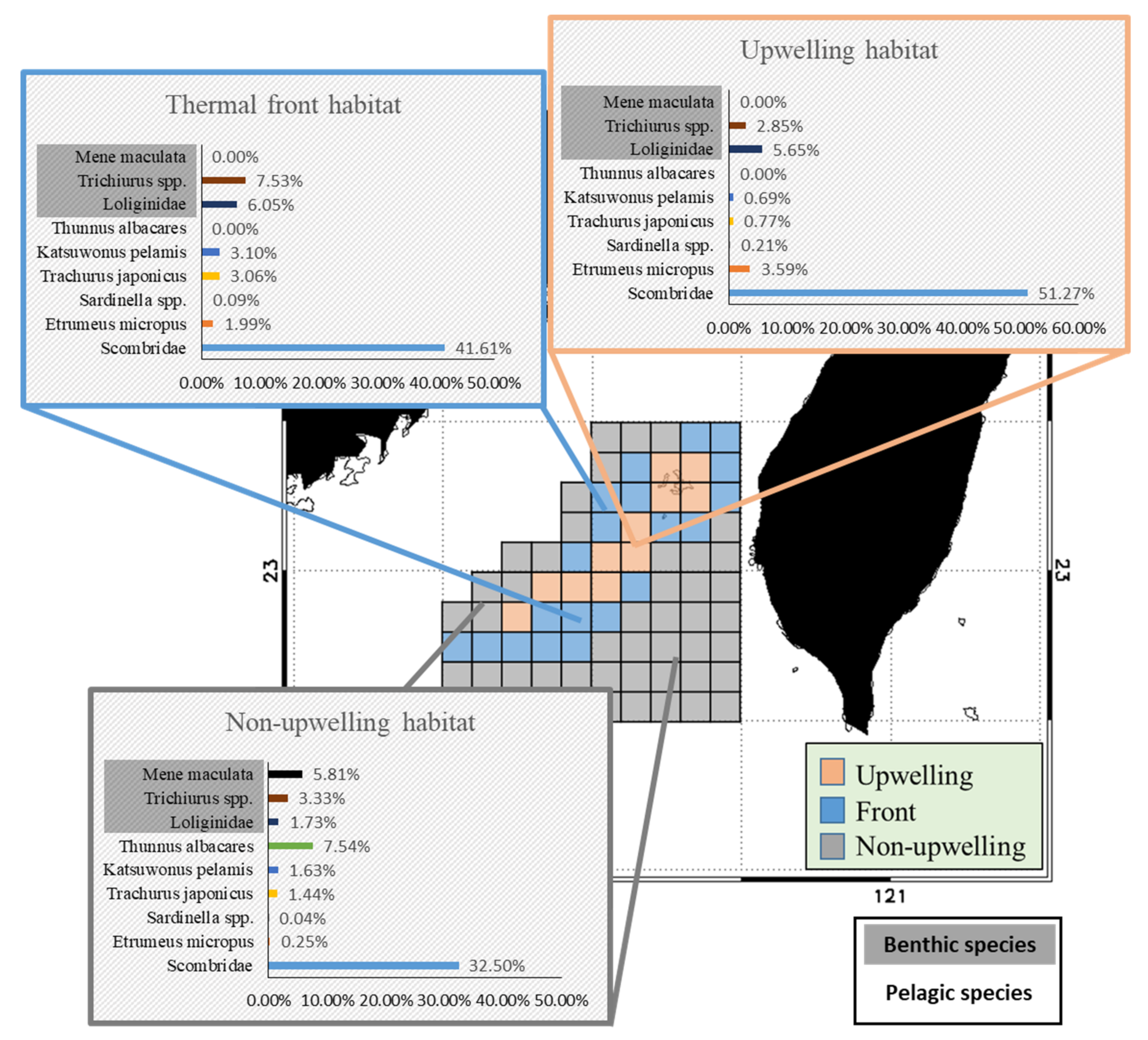

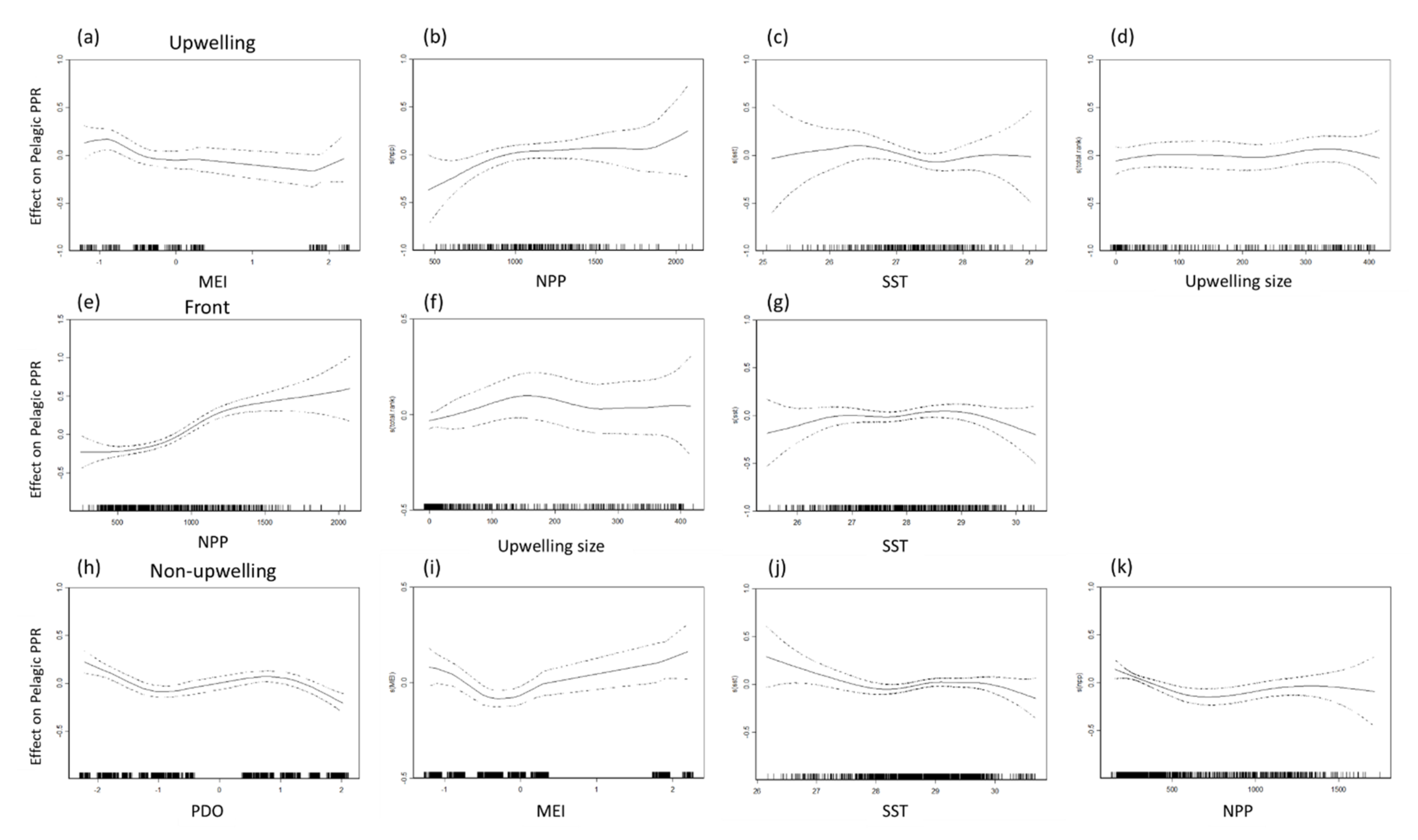
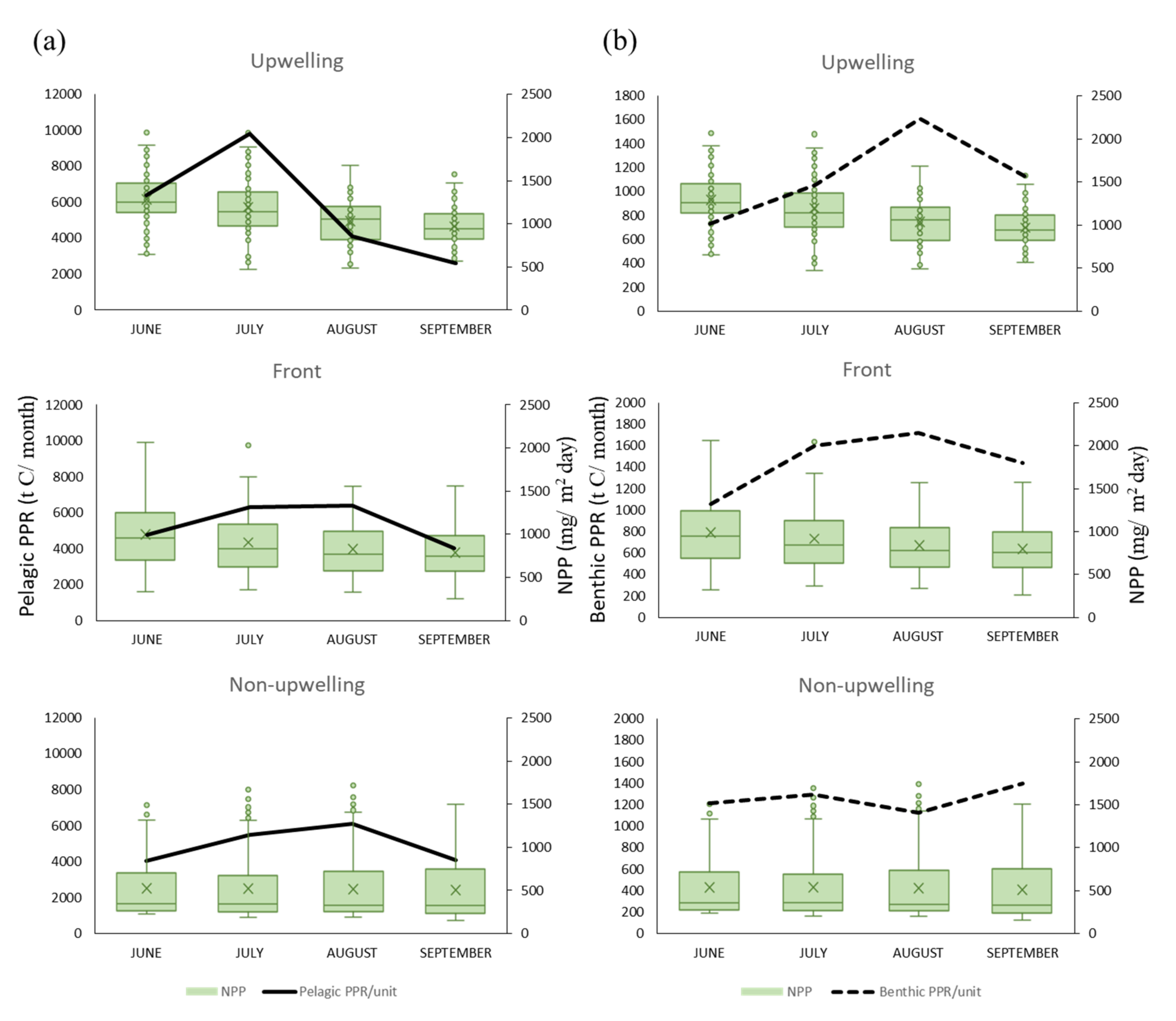
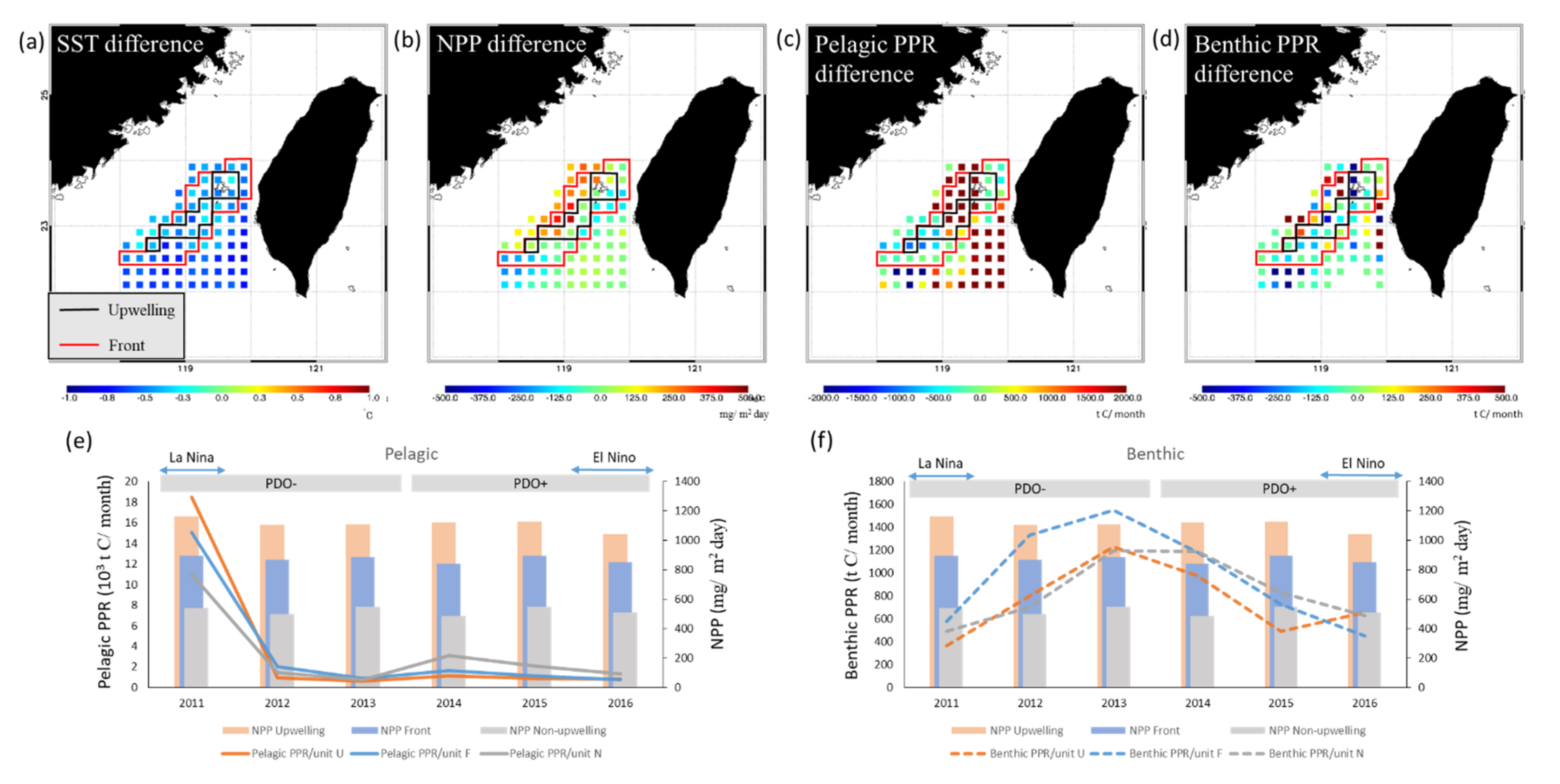
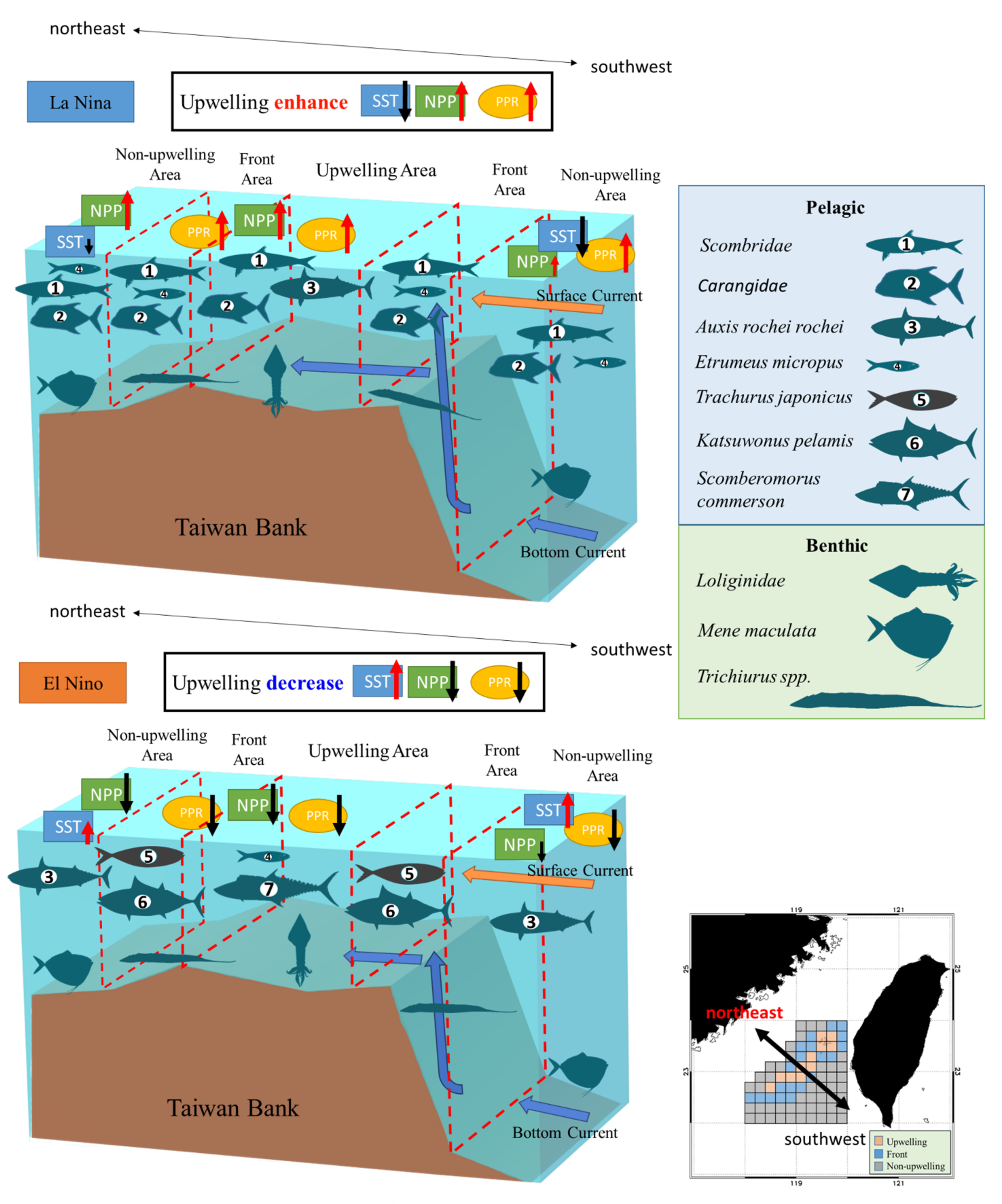
| Species | TL | Total Catch (ton) | Cumulative PPR (t C × 103) | Catch (%) | cPPR (%) | |
|---|---|---|---|---|---|---|
| Pelagic | Scombridae | 4 | 6931.77 | 770.20 | 30.90% | 37.00% |
| Carangidae | 3.7 | 1833.88 | 102.12 | 8.18% | 4.91% | |
| Trachurus japonicus | 3.4 | 1445.07 | 40.33 | 6.44% | 1.94% | |
| Scomber australasicus | 4.08 | 1251.23 | 167.14 | 5.58% | 8.03% | |
| Auxis rochei | 4.27 | 758.04 | 156.84 | 3.38% | 7.54% | |
| Etrumeus micropus | 3.5 | 624.14 | 21.93 | 2.78% | 1.05% | |
| Sardinella spp. | 2.5 | 428.02 | 1.50 | 1.91% | 0.07% | |
| Katsuwonus pelamis | 4.03 | 359.87 | 42.84 | 1.60% | 2.06% | |
| Other skipjack | 4 | 346.37 | 38.49 | 1.54% | 1.85% | |
| Thunnus albacares | 4.41 | 316.57 | 90.41 | 1.41% | 4.34% | |
| Coryphaena hippurus | 4.37 | 204.69 | 53.32 | 0.91% | 2.56% | |
| Scomberomorus commerson | 4.5 | 185.05 | 65.02 | 0.82% | 3.12% | |
| Other Pelagic species | 364.46 | 71.04 | 1.62% | 3.41% | ||
| Total Pelagic | 15,049.14 | 1621.19 | 67.09% | 77.89% | ||
| Benthic | Mene maculata | 3.45 | 2220.24 | 69.53 | 9.90% | 3.34% |
| Loliginidae | 4 | 660.97 | 73.44 | 2.95% | 3.53% | |
| Decapterus maruadsi | 3.4 | 476.18 | 13.29 | 2.12% | 0.64% | |
| Trichiurus spp. | 4.42 | 344.60 | 100.71 | 1.54% | 4.84% | |
| Pennahia argentata | 3.72 | 187.23 | 10.92 | 0.83% | 0.52% | |
| Uroteuthis chinensis | 3.87 | 184.47 | 15.19 | 0.82% | 0.73% | |
| Decapterus kurroides | 3.4 | 160.08 | 4.47 | 0.71% | 0.21% | |
| Metapenaeopsis barbata | 2 | 137.48 | 0.15 | 0.61% | 0.01% | |
| Polynemidae | 3.7 | 122.80 | 6.84 | 0.55% | 0.33% | |
| Sepia esculenta | 3.39 | 111.72 | 3.05 | 0.50% | 0.15% | |
| Atrobucca nibe | 3.96 | 96.28 | 9.76 | 0.43% | 0.47% | |
| Psenopsis anomala | 4 | 96.24 | 10.69 | 0.43% | 0.51% | |
| Metanephrops thomsoni | 2 | 88.39 | 0.10 | 0.39% | 0.00% | |
| Other Benthic species | 1616.65 | 107.75 | 7.21% | 5.18% | ||
| Total Benthic | 6503.30 | 425.88 | 28.99% | 20.46% | ||
| Others | 878.72 | 34.33 | 3.92% | 1.65% |
| Optimal Models | R-sq.(adj) | Deviance Explained | AIC | ||
|---|---|---|---|---|---|
| Upwelling | PPR_Benthic | s(NPP) | 0.17 | 19.20% | 801.49 |
| PPR_Pelagic | s(MEI) + s(NPP) + s(SST) + s(upwelling_size) | 0.124 | 16.90% | 823.55 | |
| Front | PPR_Benthic | s(NPP) + s(upwelling_size) + s(SST) | 0.272 | 28.50% | 1880.32 |
| PPR_Pelagic | s(NPP) + s(upwelling_size) + s(SST) | 0.208 | 22% | 1891.77 | |
| Non-Upwelling | PPR_Benthic | s(NPP) | 0.082 | 8.90% | 3857.91 |
| PPR_Pelagic | s(PDO) + s(MEI) + s(SST) + s(NPP) | 0.097 | 11.50% | 3717.56 |
| s(SST) | s(NPP) | s(Upwelling_Size) | s(WPO) | s(MEI) | s(PDO) | ||
|---|---|---|---|---|---|---|---|
| Upwelling | PPR_Benthic | - | 19.20% | - | - | - | - |
| PPR_Pelagic | 2.39% | 4.01% | 2.17% | - | 10.10% | - | |
| Front | PPR_Benthic | 3.75% | 27.30% | 4.83% | - | - | - |
| PPR_Pelagic | 6.41% | 21.00% | 6.83% | - | - | - | |
| Non-Upwelling | PPR_Benthic | - | 8.90% | - | - | - | - |
| PPR_Pelagic | 2.23% | 2.11% | - | - | 4.74% | 5.26% |
| La Nina | El Nino | Difference | |||||||||
|---|---|---|---|---|---|---|---|---|---|---|---|
| Species | TL | Upwelling | Front | Non-Upwelling | Upwelling | Front | Non-Upwelling | Upwelling | Front | Non-Upwelling | |
| Pelagic | Scombridae | 4 | 71.99% | 68.08% | 68.86% | 3.77% | 10.46% | 18.21% | 68.21% | 57.63% | 50.65% |
| Carangidae | 3.7 | 10.73% | 10.10% | 7.26% | 0.00% | 0.00% | 0.00% | 10.73% | 10.10% | 7.26% | |
| Auxis rochei | 4.27 | 11.31% | 1.17% | 0.00% | 0.34% | 6.18% | 28.45% | 10.97% | −5.01% | −28.45% | |
| Etrumeus micropus | 3.5 | 1.93% | 14.91% | 14.71% | 13.57% | 0.48% | 0.04% | −11.64% | 14.43% | 14.67% | |
| Trachurus japonicus | 3.4 | 0.09% | 0.00% | 0.00% | 2.42% | 4.83% | 0.16% | −2.34% | −4.83% | −0.16% | |
| Other skipjacks | 4 | 1.15% | 0.41% | 0.22% | 4.48% | 9.51% | 2.24% | −3.33% | −9.11% | −2.03% | |
| Katsuwonus pelamis | 4.03 | 0.33% | 0.09% | 0.86% | 0.01% | 19.14% | 1.60% | 0.32% | −19.05% | −0.73% | |
| Coryphaena hippurus | 4.37 | 0.10% | 0.07% | 0.13% | 3.54% | 3.35% | 3.37% | −3.44% | −3.27% | −3.24% | |
| Sardinella spp. | 2.5 | 0.00% | 0.00% | 0.04% | 0.06% | 0.04% | 1.24% | −0.05% | −0.04% | −1.20% | |
| Scomberomorus commerson | 4.5 | 0.13% | 1.11% | 0.02% | 21.70% | 0.01% | 3.48% | −21.57% | 1.10% | −3.46% | |
| Thunnus albacares | 4.41 | 0.13% | 0.00% | 0.04% | 0.01% | 1.13% | 0.03% | 0.12% | −1.13% | 0.02% | |
| Scomber australasicus | 4.08 | 0.00% | 0.07% | 0.00% | 0.35% | 0.12% | 0.08% | −0.35% | −0.05% | −0.08% | |
| Other pelagic species | - | 0.16% | 0.25% | 0.44% | 5.16% | 6.16% | 7.36% | −5.00% | −5.91% | −6.92% | |
| Total pelagic | - | 98.04% | 96.27% | 92.59% | 55.41% | 61.39% | 66.26% | 42.63% | 34.88% | 26.33% | |
Publisher’s Note: MDPI stays neutral with regard to jurisdictional claims in published maps and institutional affiliations. |
© 2021 by the authors. Licensee MDPI, Basel, Switzerland. This article is an open access article distributed under the terms and conditions of the Creative Commons Attribution (CC BY) license (http://creativecommons.org/licenses/by/4.0/).
Share and Cite
Hsiao, P.-Y.; Shimada, T.; Lan, K.-W.; Lee, M.-A.; Liao, C.-H. Assessing Summertime Primary Production Required in Changed Marine Environments in Upwelling Ecosystems Around the Taiwan Bank. Remote Sens. 2021, 13, 765. https://doi.org/10.3390/rs13040765
Hsiao P-Y, Shimada T, Lan K-W, Lee M-A, Liao C-H. Assessing Summertime Primary Production Required in Changed Marine Environments in Upwelling Ecosystems Around the Taiwan Bank. Remote Sensing. 2021; 13(4):765. https://doi.org/10.3390/rs13040765
Chicago/Turabian StyleHsiao, Po-Yuan, Teruhisa Shimada, Kuo-Wei Lan, Ming-An Lee, and Cheng-Hsin Liao. 2021. "Assessing Summertime Primary Production Required in Changed Marine Environments in Upwelling Ecosystems Around the Taiwan Bank" Remote Sensing 13, no. 4: 765. https://doi.org/10.3390/rs13040765
APA StyleHsiao, P.-Y., Shimada, T., Lan, K.-W., Lee, M.-A., & Liao, C.-H. (2021). Assessing Summertime Primary Production Required in Changed Marine Environments in Upwelling Ecosystems Around the Taiwan Bank. Remote Sensing, 13(4), 765. https://doi.org/10.3390/rs13040765






